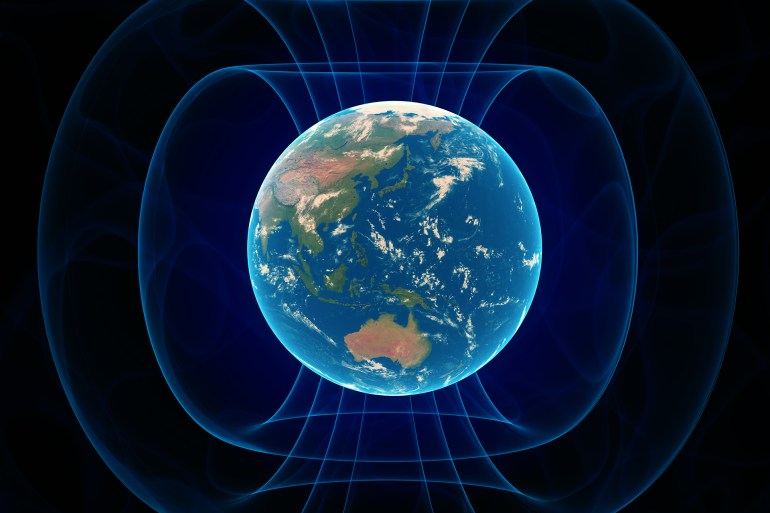Researchers at the Swiss Federal Institute of Technology (ETH) in Zurich showed in the laboratory how well the mineral "bridgmanite" - which spreads at the boundary between the Earth's core and the mantle - conducts heat between the core and the mantle, which led them to suspect that the Earth's heat It may dissipate sooner than previously thought.
A catastrophic transformation portends a wasteland
According to the press release published on the official website of the institute, the researchers stated that the evolution of our planet is a cold tale, meaning that 4.5 billion years ago, extreme cold temperatures prevailed on the surface of the young Earth that was covered with a deep ocean of magma.
Over millions of years, the planet's surface cooled to form a brittle crust.
However, the enormous thermal energy emitted from the Earth's interior drives dynamic processes such as: mantle convection, the movement of tectonic plates and volcanoes, helping to sustain life by stabilizing global temperatures and the carbon cycle.
The acceleration of the decrease in the temperature of the Earth's interior negatively affects the Earth's magnetic field (Shutterstock)
Thus, as the temperature of the Earth’s interior continues to decrease at an accelerating rate, the liquid interior of the Earth will eventually turn into a cold solid mass, and geological activity will stop at this point, and it may turn the Earth into a barren rock, similar to Mars or Mercury.
According to a report published in the "Sciene Alret" website, an international team of researchers from the Swiss Federal Institute of Technology, the Carnegie Institution of Washington in the United States, the University of Bayriot in Germany, and Okayama University in Japan have warned;
That this catastrophic transformation could happen sooner than previously thought.
The study, which was published in the journal Earth and Planetary Science Letters on January 15, warned that the acceleration of the decrease in the Earth's temperature will affect convection currents in the depths of the earth, and this will negatively affect the The Earth's magnetic field, which is the main reason for the prosperity and protection of life on planet Earth.
Bridgemanite spreads out at the boundary between Earth's core and mantle and cools the core (Flickr)
high thermal conductivity
The researchers explained that the explanation for this phenomenon lies in the mineral "bridgemanite" located on the boundary between the outer core of the Earth's iron and nickel, and the lower molten liquid from the mantle above it.
This element plays an important role in terms of the effect of how quickly it conducts heat on how quickly heat escapes from the core and out into the mantle.
This mineral was named "bridgemanite" in honor of Percy Bridgeman, a physicist who won the Nobel Prize in Physics in 1946, due to his fundamental contribution to high-pressure physics.
In order to determine the rate of its thermal conductivity, it was necessary to test the conductivity of bridgemanite in the atmospheric conditions surrounding it, there where it is located, which is very difficult, especially since the thermal conductivity can vary depending on pressure and temperature, which differ greatly in the interior of the earth from what we know on its surface .
To overcome this difficulty, a team of scientists led by planetary scientist Motohiko Murakami of the Swiss Institute, shined a pulsed laser beam on a single crystal of bridgemanite, increasing the temperature of the crystal to 2,440 K and pressure to 80 gigapascals, values close to the values that We know it in the lower mantle which is 2,630 kelvins and 127 gigapascals of pressure.
Here it should be noted that one Kelvin degree is equal to one degree Celsius, and therefore there is no difference in the same degree of degree between the Kelvin scale and the Celsius scale, but the difference lies in the zero degree, as the zero degree on the Kelvin scale is equal to –273.15 degrees on the Celsius scale.
"Our study showed that the thermal conductivity of bridgemanite is about 1.5 times higher than assumed," Murakami said.
This in turn means that the heat flow from the core into the mantle is higher than we thought, and therefore, the rate of cooling in the Earth's interior is faster than we thought.
There are other factors that may play a role in how quickly the planet's core (Al Jazeera)
It is difficult to give exact values
It must be noted here that when bridgemanite cools, it turns into another mineral called post-perovskite, which is more conductive of heat, which will increase the rate of heat loss from the core to the mantle.
The researchers pointed out that it is difficult to give accurate values about the rate of cooling, as they believe that there are other factors that may play a role in how quickly the planet's core cools.
For example, the decay of radioactive elements, which are major sources of heat in the Earth's mantle, can generate enough heat to sustain volcanic activity, but their contribution is still not fully understood and needs further investigation.
For example, Mars cools slightly faster because it is much smaller than Earth.
Finally, Murakami concluded the press release, saying, "We still do not know enough about these events, and therefore are not currently able to determine the exact time of their occurrence."

